1. Introduction to Morphology
- What it is: Mathematical morphology is a theory and technique for the analysis and processing of geometrical structures, based on set theory, lattice theory, topology, and random functions. It’s mostly applied to digital images but can be used on graphs, surface meshes, solids, and other spatial structures.
- Core Idea: Probing an image with a small shape or template called a structuring element. The shape and size of the structuring element determine the precise effect of the operation on the image.
- Basic Operators: The fundamental morphological operations are erosion, dilation, opening, and closing.
- Applications:
- Noise removal
- Image segmentation
- Feature extraction
- Edge detection
- Image enhancement
2. Structuring Elements (SE)
-
Definition: A small binary image (matrix) used to interact with the image being processed.
-
Origin: The structuring element has a defined center, called the origin, which identifies the pixel being processed.
-
Shapes: Common shapes include squares, disks, diamonds, lines, etc. The choice of shape depends on the desired effect.
-
Example (3x3 square SE):
[1 1 1] [1 1 1] [1 1 1]Where ‘1’ represents a pixel that is part of the SE, and ‘0’ is not.
3. Basic Operations
A. Erosion
-
Concept: Shrinks or thins objects in a binary image.
-
Analogy: Imagine “eroding” the boundaries of objects.
-
Operation: The structuring element is slid over the image. If the SE completely fits within the object (all ‘1’s of the SE align with ‘1’s in the image), the corresponding pixel in the output image is set to ‘1’. Otherwise, it’s set to ‘0’.
-
Mathematical Notation (for binary images): Let:
Abe the input image (a set of pixel coordinates).Bbe the structuring element.zbe a translation vector of the origin- be the translation of by
The erosion of
AbyBis denoted as or and is defined as:
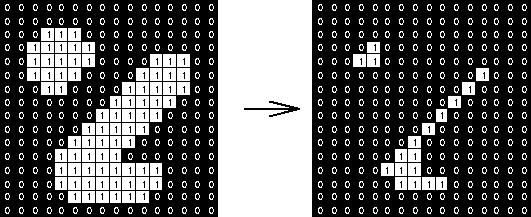
-
Effects:
- Removes small objects or details.
- Separates connected objects.
- Shrinks the size of objects.
B. Dilation
-
Concept: Expands or thickens objects in a binary image.
-
Analogy: Imagine “growing” the boundaries of objects.
-
Operation: The SE is slid over the image. If any part of the SE overlaps with the object (at least one ‘1’ of the SE aligns with a ‘1’ in the image), the corresponding pixel in the output image is set to ‘1’. Otherwise, it’s set to ‘0’.
-
Mathematical Notation (for binary images): The dilation of
AbyBis denoted as and is defined as:Where
- is the reflection of
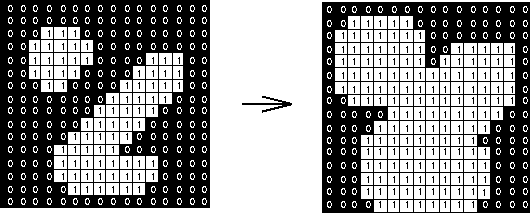
- is the reflection of
-
Effects:
- Fills small holes or gaps.
- Connects broken objects.
- Increases the size of objects.
C. Opening
-
Concept: Erosion followed by dilation, using the same structuring element.
-
Operation: First, erode the image with the SE, then dilate the result with the same SE.
-
Mathematical Notation: The opening of
AbyBis denoted asA ∘ Band is defined as: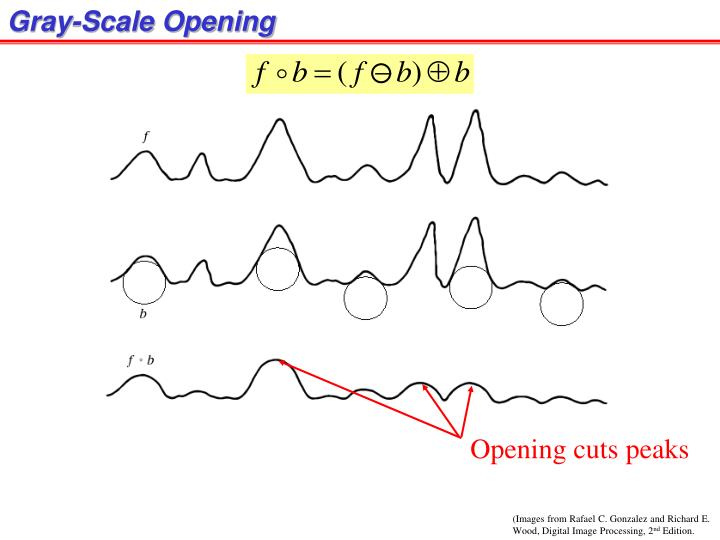
-
Effects:
- Removes small objects and thin protrusions (smoothes from the outside).
- Preserves the general shape and size of larger objects.
- Breaks thin connections.
D. Closing
-
Concept: Dilation followed by erosion, using the same structuring element.
-
Operation: First, dilate the image with the SE, then erode the result with the same SE.
-
Mathematical Notation: The closing of
AbyBis denoted asA • Band is defined as: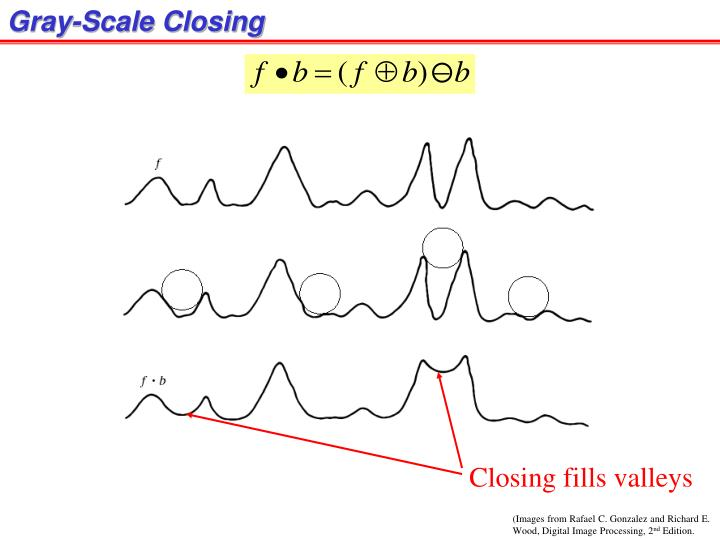
-
Effects:
- Fills small holes and gaps (smoothes from the inside).
- Preserves the general shape and size of objects.
- Fuses narrow breaks.
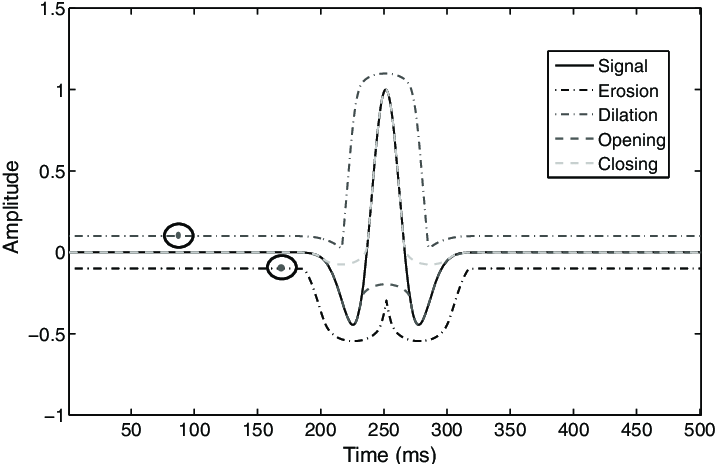
4. Top-Hat Transforms: Introduction
- Purpose: Top-hat transforms are used to extract bright or dark features from an image that are smaller than the structuring element. They are particularly useful when dealing with uneven illumination or a non-uniform background.
- Types:
- Bright Top-Hat (or White Top-Hat): Extracts bright features (peaks).
- Dark Top-Hat (or Black Top-Hat or Bottom-Hat): Extracts dark features (valleys).
1. Bright Top-Hat Transform
-
Concept: Detects bright objects or regions that “fit” within the structuring element. These objects are brighter than their surrounding pixels.
-
Operation:
- Perform an opening operation on the original image using a given structuring element.
- Subtract the opened image from the original image.
-
Mathematical Notation: Let:
fbe the input image (grayscale or binary).bbe the structuring element.- denote the opening of
fbyb.
The bright top-hat transform, , is defined as:
-
Explanation:
- The opening operation removes bright features smaller than the SE, smoothing the image from the outside.
- Subtracting the opened image from the original image isolates the features that were removed, leaving only those bright, small features.
-
Effects:
- Highlights bright objects on a darker, possibly uneven background.
- The size of the extracted features is controlled by the size of the structuring element.
-
Applications:
- Extracting bright text or objects from a non-uniformly lit background.
- Detecting bright spots or defects in images.
2. Dark Top-Hat (Bottom-Hat) Transform
-
Concept: Detects dark objects or regions that “fit” within the structuring element. These objects are darker than their surrounding pixels.
-
Operation:
- Perform a closing operation on the original image using a given structuring element.
- Subtract the original image from the closed image.
-
Mathematical Notation: Let:
fbe the input image (grayscale or binary).bbe the structuring element.- denote the closing of
fbyb.
The dark top-hat transform, , is defined as:
-
Explanation:
- The closing operation fills in dark features smaller than the SE, smoothing the image from the inside.
- Subtracting the original image from the closed image isolates the features that were filled in, leaving only those dark, small features.
-
Effects:
- Highlights dark objects on a brighter, possibly uneven background.
- The size of the extracted features is controlled by the size of the structuring element.
-
Applications:
- Extracting dark text or objects from a non-uniformly lit background.
- Detecting cracks, pits, or other dark defects.
- Shadow detection.
Morphological Feature Enhancement/Derivation
Expression:
Interpretation:
The expression combines the results of three morphological operations to produce an output image f that likely enhances features of various sizes and brightness characteristics:
-
: This component represents a smoothed version of the image where features smaller than
2Bhave been removed. It can be considered a “base” image with larger structures preserved. -
: This component highlights “medium-sized” features that fall within the scale range defined by
Band2B. -
: This component extracts small, bright features that are smaller than
B.
Possible Application Scenario:
Consider a scenario where you are analyzing an image with objects of varying sizes and intensities:
- Large, dim objects: These would be preserved in the
(f o 2B)component. - Medium-sized objects: These would be highlighted in the
(f o B - f o 2B)component. - Small, bright objects: These would be emphasized in the
(f - f o B)component (the bright top-hat).
By summing these components, the resulting image f would simultaneously enhance large structures, medium-sized objects, and small, bright details.
Weights and Adjustments:
The expression, as written, gives equal weight to each component. In a practical application, you might introduce weighting factors to adjust the contribution of each component:
Where , , and are weights that can be tuned to emphasize different feature types based on the specific needs of your application.
Variation 1: Additive Enhancement
-
Equation:
-
Components:
- Scaled Dark Top-Hat:
- Extracts dark features smaller than
nB. - Weight
w_1controls enhancement strength.
- Extracts dark features smaller than
- Bright Top-Hat:
- Extracts bright features smaller than
B. - Weight
w_2controls enhancement strength.
- Extracts bright features smaller than
- Scaled Dark Top-Hat:
-
Effect: Enhances both bright and dark small-scale details in the original image
f.
Variation 2: Subtractive Modification (Option 1 - Dark Feature Suppression)
-
Equation:
-
Components:
- Scaled Dark Top-Hat:
- Highlights dark features smaller than
nB. - Weight
w_1controls subtraction strength.
- Highlights dark features smaller than
- Dark Top-Hat:
- Highlights dark features smaller than
B. - Weight
w_2controls subtraction strength.
- Highlights dark features smaller than
- Scaled Dark Top-Hat:
-
Effect: Suppresses or reduces the intensity of dark features of different scales in the original image
f.
Key Parameters:
n: Scaling factor for structuring elementB. Controls the size range of features affected.B: Structuring element (shape and size). Determines the type of features influenced.w_1,w_2: Weights. Control the strength of enhancement or suppression.